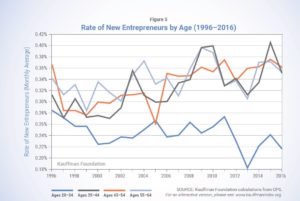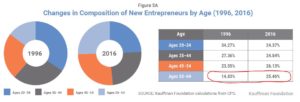Managing Yourself Into Your Second Half – Three Critical Steps

“When work for most people meant manual labor, there was no need to worry about the second half of your life. You simply kept on doing what you had always done. And if you were lucky enough to survive 40 years of hard work in the mill or on the railroad, you were quite happy to spend the rest of your life doing nothing. Today, however, most work is knowledge work, and knowledge workers are not ‘finished’ after 40 years on the job, they are merely bored.
We hear a great deal of talk about the midlife crisis of the executive. It is mostly boredom. At 45, most executives have reached the peak of their business careers, and they know it. After 20 years of doing very much the same kind of work, they are very good at their jobs. But they are not learning or contributing or deriving challenge and satisfaction from the job. And yet they are still likely to face another 20 if not 25 years of work. That is why managing one-self increasingly leads one to begin a second career.”
I stole the long quote from a short Harvard Business Review booklet entitled “Managing Oneself” by the late, great, and revered management/business guru, Peter F. Drucker.
Drucker suggests that there are three ways to develop a second career:
- Actually start one. It may mean moving from one kind of organization to another, or perhaps moving into a completely different line of work. Like a close friend of mine who took his sales skills from the high-end furniture industry to the automobile brokerage industry and thrived.
- Develop a parallel career. Another close friend and investment banking executive prepared himself for a parallel career in Christian counseling by getting a Master of Divinity on top of his MBA. He functions in both roles with a thriving counseling business where heart and wisdom team up to change lives one at a time. With the changes and volatility taking place in the banking/brokerage world, his decision may prove prescient.
- Be a social entrepreneur. These are people who have been successful in their first careers but are no longer challenged. Very much like my friend Ron Benfield who I wrote about in my 3/2/20 article. Ron fit this scenario. Unchallenged and passed over in his large hospital CFO role, he started his own healthcare consulting firm which thrives two years later providing services back to hospitals solving the same problems he solved as a successful CFO. But now he provides employment to a team of skilled professionals who were also escaping the corporate handcuffs.
Option #3 appears to be alive and well – –
According to the U.S. Bureau of Labor Statistics, the self-employment rate among workers 65 and older (who don’t incorporate) is the highest of any age group in America: 15.5 percent. In sharp contrast, it’s 4.1 percent for ages 25 to 34. We’ve known for some time that more businesses are started by people over 50 than any other age group.


– – but the majority still don’t plan for their second half.
Drucker comes to a conclusion similar to my observation as I connect with mid-life professionals.
He says:
“People who manage the second half of their lives may always be a minority. The majority may ‘retire on the job’ and count the years until their actual retirement. But it is this minority, the men and women who see a long working-life expectancy as an opportunity both for themselves and for society, who will become leaders and models.”
Why is it that the majority fail to plan for the second half? Perhaps it is not accepting the fact that living longer will inevitably include some level of a major setback in work or life. Whether it is being passed over, being a victim of a downsize, a marriage breakup, loss of a child, a second major interest – beyond a hobby – can make a huge difference.
How do I do this?
Let me share three suggestions that should help:
1. Start early. Drucker suggests beginning long before entering the second half, noting that all the social entrepreneurs he knew began to work on their chosen second career long before they reached the peak of their original careers. Much of this can happen through volunteering, pursuing one’s curiosity, experimenting while at the same time expanding awareness of opportunities and needs in the world. Drucker makes the point that “- if one does not begin to volunteer before one is 40 or so, one will not volunteer once past 60.”
2. Get reacquainted with your real self. We all start with an “essential self” and it sticks with us until we are no longer. Martha Beck, author of the seminal book “Finding Your Own North Star: Claiming the Life You Were Meant to Live” describes it as:
“–the personality you got from your genes: your characteristic desires, preferences, emotional reactions, and involuntary physiological responses, bound together by an overall sense of identity.”
Unfortunately, career pursuit, conformity, building another’s dreams, and chasing the paycheck can push that essential self to the background. Beck suggests it is the formation of a “social self” or “– that part of you that developed in response to pressures from the people around you and was shaped by cultural norms and expectations.”
The aforementioned major setback has a way of bringing that essential self forward. Rather than wait for the setback, mid-life is a time to reflect, reassess, and resurrect that core, essential self and commit – through experimentation – to finding a way to apply it in the second half.
Kick start the process by asking yourself:
- What am I really, really good at?
- What do I really, really want to do?
- What does the world need?
3. Grow, learn, expand, be curious. Now is a good time to not only rediscover your essence but also beef up your skills. Discovering your essence should reacquaint you with your talents. Now is a good time to burnish those talents with deeper skills and turn them into deeper strengths. Take some classes; go for a new or another certification; volunteer and learn something new. It’s easy to flat-line intellectually at this mid-point, stay stuck in old ways, and be unprepared for the unexpected.
Be the CEO of your second half.
I’ll wrap with another quote from Drucker:
“Every existing society, even the most individualistic one, takes two things for granted, if only subconsciously: that organizations outlive workers, and that most people stay put.
But today the opposite is true. Knowledge workers outlive organizations, and they are mobile. The need to manage oneself is therefore creating a revolution in human affairs.”
I hope this may help you join the revolution.
Share a comment below. Thanks for actively participating in the discussion. Join our email list if you haven’t already by going to www.makeagingwork.com. You’ll receive our free ebook “Achieve Your Full-live Potential: Five Easy Steps to Living Longer, Healthier, and With More Purpose.”
Stay safe!





BH
Amazing. Im a behavioral neurologist researching the effects retirement. Id be happy to talk.
Dr Yakir Kaufman
Thanks for using my “Honey “ as an example. I think I know the second guy whose name begins with a T. Good message
Its excellent as your other blog posts : D, appreciate it for posting.
To the makeagingwork.com administrator, You always provide valuable feedback and suggestions.
Dear makeagingwork.com owner, You always provide valuable information.
Dear makeagingwork.com admin, Your posts are always well-balanced and objective.
very good submit, i actually love this web site, keep on it
Hi makeagingwork.com webmaster, You always provide helpful information.
Dear makeagingwork.com webmaster, Your posts are always well-supported by research and data.
To the makeagingwork.com owner, Great post!
Hello makeagingwork.com owner, Great job!
Dear makeagingwork.com owner, Great post!
Hello makeagingwork.com admin, Your posts are always well-timed and relevant.
Dear makeagingwork.com webmaster, You always provide clear explanations and step-by-step instructions.
Dear makeagingwork.com administrator, Your posts are always well-supported and evidence-based.
Hello makeagingwork.com owner, Thanks for the informative post!